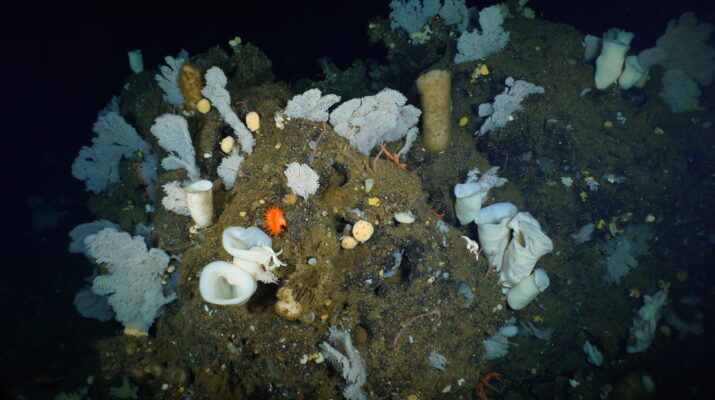[From Deep-Sea Life 16]
Lizzie Duncan
NOAA Office of National Marine Sanctuaries
From September 20 through October 26, 2020, the National Oceanic and Atmospheric Administration’s (NOAA) Office of National Marine Sanctuaries and the Ocean Exploration Trust partnered to bring 26 sea days to E/V Nautilus expeditions in U.S. West Coast sanctuaries. A total of 26 remotely operated vehicle dives (300 hours of bottom time) were conducted, and 393 biological and geological samples were collected within and around Olympic Coast, Greater Farallones, Monterey Bay, and Channel Islands National Marine Sanctuaries. The on-board team also mapped 10,806 km2 of seafloor between the Olympic Coast and Monterey Bay sanctuaries.

Highlights from the exploration expeditions include colorful colonies of corals and sponges, methane seeps and hydrates, thousands of brooding octopuses, a whale fall (carcass on the seafloor), and the discovery of diverse sponge gardens adjacent to an even more astonishing and expansive landscape of dead glass sponge mounds. A variety of research and exploration objectives chosen by sanctuary staff, NOAA Fisheries, and external partners were successfully completed due to the dedication and flexibility of personnel involved in mission planning and execution. Considering the many accomplishments of the 2020 Nautilus field season, perhaps most notable is that the expeditions were conducted by a reduced Nautilus crew and guided remotely, via telepresence technologies, by 28 shoreside scientists from their homes and offices.

The data and information gathered from the expeditions are publicly available and will expand resource managers’ understanding of the diversity and distribution of deep-sea habitats within sanctuaries and across the U.S. West Coast. The new discoveries of rare and unique communities provide a strong foundation for further exploration and characterization of these areas in the future.

